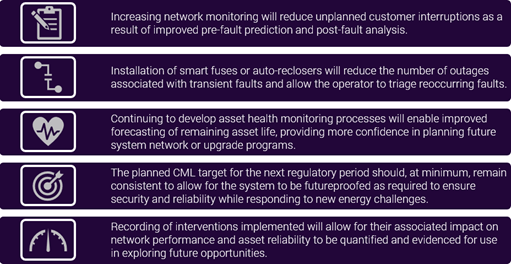Performance CML Incentive Case Study
-
09 June 2023
-
Louise Guthrie
Why was this project needed?
Distribution Network Operators (DNOs) face increasing challenges in balancing the upgrades to their networks required to reduce fault related outages with the planned system downtime those reinforcements require. Customer Minutes Lost (CML) and Customer Interruptions (CI) are metrics recorded by every DNO to measure the level of disruption to customers. Unplanned CML are those where the customer has not been warned of an outage and are related to faults or external interaction with the electricity network. Planned outages are communicated to the end customer ahead of time and are used to maintain, reinforce, or upgrade the system.
EA Technology reviewed historical data around outages: the types of outages, their length, the assets involved, and the impact on customer supply to understand the existing baseline for CML and CI. This review included both unplanned and planned outages to provide a breakdown on where interventions may reduce one type of outage.
What we found
The review EA Technology undertook highlighted areas that could provide the greatest improvement in unplanned CML performance while minimising additional planned outages. It also indicated improvements that could be made to the client’s ways of work for planned outages to ensure the most critical operations are carried out first.
EA Technology found that a large proportion of historic fault outages were potentially non-permanent or transient events. These were responsible for a larger volume of CI than CML in comparison to other types of faults, such as those associated with asset failure. This means, with the present return to service action being a fuse replacement and a watch notice, a possible solution would be the addition of an automatic recloser, or “smart fuse” that allows the transient fault to clear before reconnecting the circuit. This would remove many outages that would have previously taken customers off supply and allow repair staff to focus on faults that persist, which could improve CML for other types of outages. Smart fuses can also provide insights into the fault that would otherwise be unknown without LV monitoring systems.
Ageing asset bases generally require more maintenance and repairs than freshly installed assets. Without a full asset health history, it is difficult to estimate the future probability of failure of an asset. However, some asset fault information can be assumed, allowing asset types with disproportional volumes of failures to be targeted in future planned works. Ensuring DNOs have the health information for their assets will enable them to proactively identify which assets have a suitable life expectancy and those that require replacement before failure. Planned works can be used to reduce unplanned faults by focussing on assets that have a high failure rate or are increasingly aged, maximising the impact of the works.
Benefit to Client:
EA Technology provided a series of recommendations to reduce unplanned fault outages and maximise the effectiveness of the available planned outage time. The five recommendations were as follows:

